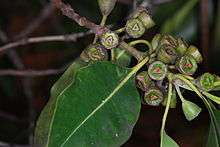Lophostemon confertus
| Lophostemon confertus | |
|---|---|
 | |
| Scientific classification | |
| Kingdom: | Plantae |
| (unranked): | Angiosperms |
| (unranked): | Eudicots |
| (unranked): | Rosids |
| Order: | Myrtales |
| Family: | Myrtaceae |
| Genus: | Lophostemon |
| Species: | L. confertus |
| Binomial name | |
| Lophostemon confertus (R.Br.) Peter G.Wilson & J.T.Waterh. | |
| Synonyms[1] | |
| |
Lophostemon confertus (syn. Tristania conferta), is an evergreen tree native to Australia, though it is cultivated in the United States and elsewhere. Common names include brush box, Queensland box, Brisbane Box, pink box, box scrub, and vinegartree.[2] Its natural range in Australia is north-east New South Wales and coastal Queensland[3] but it is commonly used as a street tree in Sydney, Melbourne, Perth and other cities in eastern Australia.
It is considered useful as a street tree, due to its disease and pest resilience, its high tolerance for smog, drought and poor drainage, and the fact that it needs only moderate-to-light upkeep.[4] It often requires lopping to accommodate overhead power lines, but survives pruning quite well.[5] It has a denser foliage and hence provides more shade than eucalypts, and is considered safer than eucalypts because it rarely sheds limbs. In form it is used as a replacement for the weedy Camphor Laurel (Cinnamomum camphora) while having a low potential for being weedy itself.

The species was formally described in 1812 by Scottish botanist Robert Brown, based on plant material collected from the Hunter River region in New South Wales. Brown named the species Tristania confertia. The species was transferred to the genus Lophostemon in 1982.[6]
In the wild its habitat ranges from moist open forest and rainforest ecotones, where it might reach heights of 40 metres or more, to coastal headlands where it acquires a stunted, wind-sheared habit.
References
| Wikimedia Commons has media related to Lophostemon confertus. |
| Wikispecies has information related to: Lophostemon confertus |
- ↑ "The Plant List: A Working List of All Plant Species".
- ↑ Hyland, B. P. M.; Whiffin, T.; Zich, F. A.; et al. (Dec 2010). "Factsheet – 'Lophostemon confertus'" Check
|url= - ↑ "Atlas of Living Australia".
- ↑ Friends of the Urban Forest
http://www.fuf.net/tree/brisbane-box/ - ↑ Shire of Yarra Ranges, Streetscape Strategy
http://www.yarraranges.vic.gov.au/files/F9CFF3E3-E1F0-4DF2-892E-9DA501084B96/Lophostemon_confertus.pdf - ↑ "' 'Tristania conferta R.Br.". Australian Plant Name Index (APNI), IBIS database. Centre for Plant Biodiversity Research, Australian Government. Retrieved 30 July 2013.